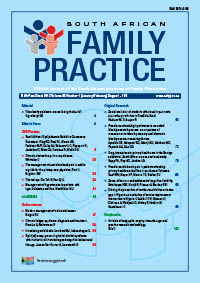Management of hypertension in patients with type 2 diabetes mellitus
Abstract
Hypertension and diabetes co-exist. The prevalence of hypertension is higher in patients with type 2 diabetes mellitus, while patients with hypertension have a higher incidence of developing type 2 diabetes mellitus. Hypertension in patients with diabetes is linked to cardiovascular disease, strokes, the progression of renal disease and diabetic retinopathy. Any 10 mmHg drop in blood pressure is associated with a reduction in the rate of diabetes- related mortality by 15%, myocardial infarction by 11% and microvascular complications of retinopathy or nephropathy by 13%. According to the Society for Endocrinology, Metabolism and Diabetes of South Africa, target blood pressure in patients with hypertension and diabetes is between 120/70 mmHg and 140/80 mmHg. Different studies have demonstrated that adequate blood pressure control improves outcomes, especially strokes, when the blood pressure target is achieved. The United Kingdom Prospective Diabetes Study (UKPDS) 38 reported that tight blood pressure control in patients with type 2 diabetes mellitus reduced the risk of diabetes-related deaths, complications related to diabetes, progression to diabetic retinopathy and deterioration in visual acuity. Tight blood pressure control in patients with type 2 diabetes mellitus also reduces the costs of complications. In UKPDS 39, it was found that by preventing diabetes-related complications in patients with hypertension, the choice of antihypertensive drugs to control blood pressure was less important than the blood pressure control. It is very important for clinicians to be familiar with the different classes of drugs that are commonly used to control hypertension in patients with type 2 diabetes mellitus. This information will assist clinicians to prevent or delay the progression of diabetic complications. The drug classes that are commonly used in the management of hypertension in patients with diabetes mellitus are angiotensin-converting enzyme inhibitors, calcium-channel blockers, angiotensin II-receptor blockers, thiazide diuretics and beta blockers.
Published
2013-01-15
Section
CPD
By submitting manuscripts to SAFP, authors of original articles are assigning copyright to the South African Academy of Family Physicians. Copyright of review articles are assigned to the Publisher, Medpharm Publications (Pty) Ltd, unless otherwise specified. Authors may use their own work after publication without written permission, provided they acknowledge the original source. Individuals and academic institutions may freely copy and distribute articles published in SAFP for educational and research purposes without obtaining permission.

